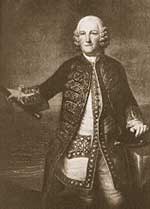George Anson

Baron af Soberton og engelsk admiral.
- Finisterre Kap I, 1747
Anson, George, baron af Soberton, Lord (1697-1762), engelsk søofficer, kæmpede mod Spanien 1718, angreb 1741 de spanske provinser i Sydamerika og vendte 1744 tilbage til England over det stille ocean og syd om Afrika. Blev 1746 viceamiral og slog 1747 den franske flåde ved Kap Finisterre. Hans jordomsejling 1740-44 er beskrevet af Walter og oversat på dansk. (HK1/1920)
Anson, in
addition to having a significant developmental impact on the British royal
navy of the day, was very influential in the careers of both Warren and
of Boscawen, admirals who did have a direct connection with Nova Scotia.
One would be hard pressed to find a man of the royal British navy who
was more decorated and honoured than George Anson: As a 15 year old he
entered the navy, at 21 an officer and by 27 he was the captain of his
own naval ship. After a spectacular round the world trip, lasting three
years and nine months, Anson was made a rear-admiral, in 1744. Having
defeated the French fleet off of Cape Finisterre, in 1747, Anson was made
a vice-admiral and raised to the peerage.1 He was made a full admiral
in 1748; first lord of the admiralty. Not everyone thought that Anson
was the best choice for the high rank of The First Lord of the Admiralty;
"... a position in which he disappointed everyone."2, yet, in
1751, and, just a year before his death, the 59 nine year old took the
highest rank existing, admiral of the fleet.3
"Anson moved freely in the corridors of power." He was "very much a man of his age. His predominant characteristic was a rational calm which no adverse circumstance could shake."4 These characteristics, one might imagine were the characteristics of Warren and Boscawen, men who worked directly under Anson and who were promoted by Anson to high positions within the navy.
Incidentally, a number of important developments of the British navy came about during Anson's time. One was the progression of naval dress; a specific naval uniform emerged. "It was in Anson's time that a regular uniform was laid down for naval officers, though it was many years before the bulk of them readily conformed to it." Also, too, under Anson, the navy struck a system5 by which their warships were rated.